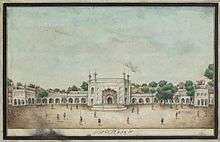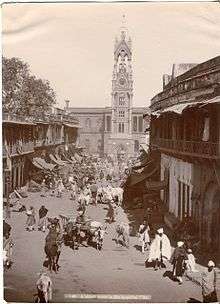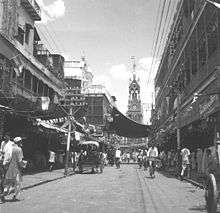Ghantaghar
Ghantaghar (literally clock-tower) is a location in the center of Chandni Chowk, Delhi, where an iconic clock tower, termed Northbrook Clocktower during early 20th century, stood originally built in 1870 stood until its partial collapse and subsequent demolition in 1950s.[1] The term "Chandni Chowk" (translation: silvery or moonlit square) originally referred to this location which later came to designate the entire street. The Ghantaghar location has been regarded as the center of Delhi, and even now serves as a center for major civic events.[2] Today, Delhi Town Hall is located at the site.
It was perhaps the oldest clock tower in India, constructed before Rajabai Clock Tower, Mumbai, 1878, Husainabad Clock Tower, Lucknow, 1881, and Secunderabad Clock Tower, Secunderabad, 1897. While the clock tower is long gone, the location is still termed Ghantaghar within Old Delhi.
Ghantaghar was the location of some of the events relating to Indian's freedom movement. On March 30, 1919, many protesters were killed by the British soldiers.[3] It is still a very popular spot for organizing protests.

The Caravanserai and Town Hall
The old city of Delhi was laid out by princess Jahanara Begum, who constructed an elegant caravanserai on the East side of the street with gardens in the back. Herbert Charles Fanshawe, in 1902, mentions about the serai:
- "Proceeding up the Chandni Chauk and passing many shops of the principal dealers in jewels, embroideries, and other products of Delhi handicrafts, the Northbrook Clock Tower and the principal entrance to the Queen's Gardens are reached. The former is situated at the site of the Karavan Sarai of the Princess Jahanara Begum (p. 239), known by the title of Shah Begum. The Sarai, the square in front of which projected across the street, was considered by Bernier one of the finest buildings in Delhi, and was compared by him with the Palais Royal, because of its arcades below and rooms with a gallery in front above. Bernier was of opinion that the population of Delhi in 1665 was much the same as that of Paris, a striking instance of how population follows the court in the East. The gardens must at one time have been extremely beautiful specimens of eastern pleasure retreats, and even now are very pretty." [4]
The serai was demolished perhaps even before the ghadar of 1857. The seari was replaced by the Victorian-Edwardian architecture [5] building now known as the Town Hall, and the pool in the middle of the square was replaced by a grand clock tower. The Town Hall was actually planned before the Revolt, and was built in 1860-5, as a center for the Europeans and was initially called the Lawrence Institute. The Institute, contained a Darbar Hall with a publio library and reading rooms. According to MCD, the Town Hall had been planned to serve as an office for the municipality, chamber of commerce, a literary society and a museum to ‘improve the local minds and to forward intercourse between Europeans and natives.’ [6]

The Northbrook Clock tower
In front of Lawrence Institute, in the center of the Chandni Chauk, a 128 feet tall lofty Gothic clock-tower with four faces was constructed.[7]
Built by Delhi Municipality at a cost of Rs. 28,000, it was formally termed the Northbrook Clocktower.[8] after Thomas Northbrook, the Viceroy of India from 1872 to 1876. Northbrook hotel, a famous hotel near the Moree gate was also named after him. The tower is said to have been 80 years old when it collapsed, implying its construction occurred in 1870.
It was actually standing in 1870 already according to Alfred Harcourt who wrote in 1870:[9]
- Facing the Delhi Institute on the Chandnee Chouk side, is a handsome and well-finished Clock Tower with four faces, and a chime of five bells. The City is indebted for this useful as well as ornamental structure also to the Municipal Committee at a cost of Rupees 25,500. It is 128 feet above the ground.
It is said that the pigeons sat on its hands so that it never showed the correct time. When Lord Northbrook visited Delhi, he did not quite like the architecture.[10]
Statue of Queen Victoria
Inside the railings of the street a Statue of Queen Victoria, the late Queen Empress of India, was placed by Mr James Skinner, a grandson of Colonel Skinner, C.B. in front of the Municipal building. [4]


The bronze statue of Queen Victoria stood between the tower and the municipal building in 1902. [11] also image on cover [12] The statue of Queen Victoria was later moved to Delhi College of Art [13]
Partial collapse and dismantling
When India became independent on August 15, 1947, GhantaGhar, was lit up for the occasion and the Union Jack on the top was replaced by a tiranga.[14]
The upper part of the tower collapsed in 1950, killing some local citizens. That resulted in a court case Municipal Corporation of Delhi v. Subhagwanti, AlR 1966 SC 1750 [15] Mr. Chakravarty, the Municipal Engineer, mentioned that the building was 80 years old and the expected life of the structure of the top storey, considering the type of mortar used, could be only 40 to 45 years, and the surviving middle storey could be saved for another 10 years. The High Court also took into consideration the statement of a Mr. Puri that when he inspected the building after the collapse and examined the mortar, he found that the mortar was reduced to powder without any cementing properties.[16]
The Municipal Corporation later allocated allocated 2 lakh in 1957 for rebuilding, however the structure had come to be known as an English relic, and thus it was never rebuilt.
Legacy
The clock tower in Sabzi Mandi, Ramrup Tower, 1941, was inspired by the Ghantaghar tower, and it survives to this day.[17][18]
In popular culture
An old song recalls the clocktower (ghantaghar) that once stood in the center, and India's freedom struggle ( video search):
घंटाघर की चार घड़ी,
चारों में ज़ंजीर पड़ी,
जब भी घंटा बजता था,
खड़ा मुसाफिर हंसता था।
हँसता था वो बेधड़क
आगे देखो नयी सड़क |
नयी सड़क पर बुआ बाजरा
आगे देखो शहर शाहदरा |
शहर शाहदरा में लग गयी आग
आगे देखो गजियाबाद |
गजियाबाद में फूटा अंडा
उसमे से निकला तिरंगा झंडा |
झन्डे से आई आवाज़
इंक़लाब ज़िन्दाबाद ||
It recalls the satyagrah by Swami Shraddhanand in 1930s near the Ghantaghar. Close the site, now his statue marks the event.
When film producer B.R. Chopra made his comedy Hindi film Chandni Chowk (1954), he made sure that a replica of Ghantaghar is included.[19]
See also
- Ghantewala
- Nai Sarak
- St. James' Church, Delhi
- Secunderabad Clock Tower 1986
- Rajabai Clock Tower 1878
- List of clock towers
- Ghanta Ghar (Multan)
References
- ↑ Frances Pritchett. "Clock Tower, Chandni Chowk, Delhi". columbia.edu. Retrieved 2015-03-06.
- ↑ "मोदी के शपथ लेते ही जश्न का माहौल Bhaskar News Network". bhaskar.com. May 27, 2014. Retrieved 2015-03-06.
- ↑ Kapoor, M.R. (1999). Revolutionary movement: Famous Episode. Iṃsṭīcyūṭa āpha Sośala Sāiṃsisa ke lie Kansepṭa Pabliśinga Kampanī. p. 180. ISBN 9788170227519. Retrieved 2015-03-06.
- 1 2 Fanshawe, H.C. (1902). Delhi Past and Present. J. Murray. p. 52. Retrieved 2015-03-06.
- ↑ "Landmark building with uncertain fate, Nivedita Khandekar, Hindustan Times New Delhi, December 08, 2012". hindustantimes.com. Retrieved 2015-03-06.
- ↑ "From civic centre to museum, Kusum Kanojia, Aug 29, 2012". m.deccanherald.com. Retrieved 2015-03-06.
- ↑ Punjab (1883). Punjab gazetteers, 1883, bound in 10 vols., without title-leaves. p. 314. Retrieved 2015-03-06.
- ↑ John Murray (Firm); Fanshawe, H.C. (1907). A Handbook for Travellers in India, Burma and Ceylon: Including the Provinces of Bengal, Bombay, Madras, the United Provinces of Agra and Lucknow, the Panjab, the North-west Frontier Province, Beluchistan, Assam, and the Central Provinces, and the Native States of Rajputana, Central India, Kashmir, Hyderabad, Mysore, Etc. ... J. Murray. p. 201. Retrieved 2015-03-06.
- ↑ The New Guide to Delhi, Alfred Frederick Pollock Harcourt, Edition 2, Published 1870, p.21
- ↑ The Delhi Omnibus, Thomas George Percival Spear, Narayani Gupta, Robert Eric Frykenberg, Oxford University Press, 2002, p. 86]
- ↑ Ek Delhi Aur. Atmaram & Sons. p. 49. Retrieved 2015-03-06.
- ↑ "Parlanti Bronze Foundries - Castings". parlantibronzefoundries.co.uk. Retrieved 2015-03-06.
- ↑ "The crowned in a corner, SANGEETA BAROOAH PISHAROTY, The Hindu, June 15, 2014". thehindu.com. Retrieved 2015-03-06.
- ↑ "There Were A Million Revellers That Night, August 1947, and a 20-year-old with a camera. A never-before-seen album. Munir Kadri, Outlook, Aug 20, 2007". outlookindia.com. Retrieved 2015-03-06.
- ↑ Arora, M. Law Students Companion QA. Universal Law Publishing. p. 197. ISBN 9788175344938. Retrieved 2015-03-06.
- ↑ "Municipal Corporation Of Delhi vs Subhagwanti & Others(With ... on 24 February, 1966". indiankanoon.org. Retrieved 2015-03-06.
- ↑ Sharma, R. (1995). Bhangi, Scavenger in Indian Society: Marginality, Identity, and Politicization of the Community. MD Publications. p. 38. ISBN 9788185880709. Retrieved 2015-03-06.
- ↑ "Left behind by the times, SANGEETA BAROOAH PISHAROTY, Hindu, May 26, 2014". thehindu.com. Retrieved 2015-03-06.
- ↑ Chandni Chowk 1954, B.R. Chopra producer, scene at 1:57